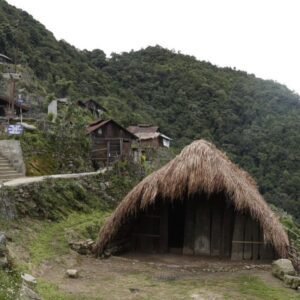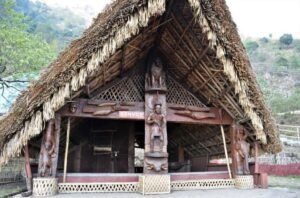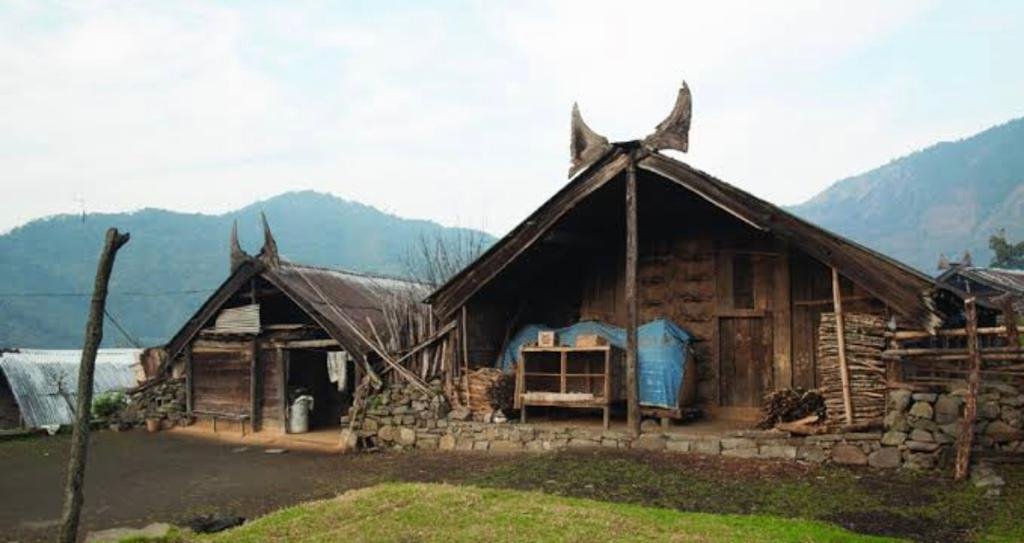Nagaland is a region rich in cultural diversity and home to several indigenous tribes. Each of these tribes has its unique architectural style, reflecting their distinct socio-cultural identities, craftsmanship, and traditional knowledge. Nagaland’s traditional structures and designs exhibit an amalgamation of artistry, practicality, and a deep connection with nature.
1. Huts

The primary form of traditional architecture in Nagaland is the Naga hut or house, usually constructed using locally available materials like bamboo, wood, thatch, and sometimes stone. The huts are often elevated on stilts, protecting from floods and wild animals while acting as storage space underneath. The design of these huts varies across tribes, but they generally follow a similar basic structure.
Huts hold significant cultural importance among the Nagas, a group of indigenous tribes residing in the northeastern state of Nagaland, India. These traditional structures are central in shaping the Naga way of life, social interactions, and deep-rooted connection with nature and ancestral traditions. The cultural significance of huts among the Nagas can be understood through the following aspects:
- Identity and Heritage: Huts symbolise the Naga identity and cultural heritage. These huts architectural style, construction techniques, and unique designs vary among different Naga tribes, reflecting their distinct cultural backgrounds and traditions. The huts remind them of their ancient way of life and maintain a sense of pride in their cultural roots.
- Social Structure: Huts are integral to the Naga social structure. In traditional Naga villages, the huts are usually clustered together, forming a community-centric layout. Each hut represents a family or a lineage, and the arrangement reflects the interconnectedness and interdependence of the community members.
- Traditional Architecture and Craftsmanship: The construction of Naga huts involves indigenous knowledge, craftsmanship, and communal effort. Bamboo, wood, thatch, and locally sourced materials build these eco-friendly structures. The construction process often involves rituals and ceremonies, making it a spiritually significant event for the community.
- Communal Living and Bonding: Naga huts are designed to facilitate communal living. The huts open spaces and common areas serve as gathering places for social interactions, festivals, and other communal activities. The proximity of the huts fosters a strong sense of bonding, cooperation, and mutual support among the community members.
- Connection with Nature: Traditional Naga huts are built harmoniously with the natural surroundings. Using bamboo and thatch materials allows the huts to blend seamlessly with the environment. This connection with nature reflects the Nagas reverence for their natural surroundings and belief in living in balance with the ecosystem.
- Rituals and Ceremonies: Naga huts are integral to various rituals and ceremonies in their culture. Many significant life events, such as births, marriages, and deaths, are marked with rituals conducted within the huts. These ceremonies strengthen familial and social bonds and reinforce cultural values and beliefs.
- Resilience and Adaptability: The design of Naga huts reflects the pragmatic approach of the Nagas to their environment. The raised stilts protect the huts from floods and wild animals, while the thatched roofs provide insulation from the region’s varying climatic conditions. This adaptability of their architectural design showcases the ability of the Nagas to live in harmony with their challenging surroundings.
Huts have profound cultural significance among the Nagas, going beyond mere shelter. They represent the essence of Naga identity, communal living, and their close relationship with nature. These traditional structures remind them of their heritage, and their continued presence in Naga society reinforces preserving their rich cultural traditions for future generations.
2. Morungs

Morungs are communal dormitories used by several tribes, primarily to accommodate unmarried men and boys. These structures are crucial in passing on cultural traditions, knowledge, and oral history to the younger generations. Morungs are often adorned with intricate carvings and paintings, showcasing the tribe’s distinctive artistic expressions.
The Morung holds immense cultural significance among the Nagas, particularly in the traditional societies of various Naga tribes in the northeastern state of Nagaland, India. Morung can be understood as a communal dormitory or a youth dormitory, and its role goes beyond being a physical structure. It serves as a vital institution that plays a central role in shaping the social, cultural, and educational aspects of Naga life. The cultural significance of Morung among the Nagas can be explored through the following aspects:
- Cultural Education and Transmission of Knowledge: The Morung is a crucial institution for imparting cultural education and transmitting traditional knowledge to the younger generations. Elders and experienced community members serve as mentors, passing down the tribe’s customs, rituals, history, folklore, and traditional skills to the youth residing in the Morung. This ensures the continuity of their cultural heritage and fosters a strong sense of identity among the Nagas.
- Social Cohesion and Communal Living: Morungs are a hub for social interactions and community bonding. Young boys and unmarried men live together in the Morung, sharing experiences and responsibilities and forming strong bonds with one another. This communal living fosters a sense of unity, cooperation, and mutual support within the tribe.
- Skill Development and Craftsmanship: Morungs offer a platform for skill development and craftsmanship in addition to cultural education. The youth residing in the Morung are exposed to various practical skills, such as traditional craftsmanship, hunting, farming, and other essential survival techniques. This hands-on learning contributes to the self-sufficiency and resilience of the Naga society.
- Initiation Ceremonies and Rites of Passage: Morungs are closely associated with various initiation ceremonies and rites of passage that mark significant milestones in a Naga individual’s life. These ceremonies include initiations into adulthood, warriorhood, and other social roles. The Morung serves as the venue for these rites, reinforcing the sense of community and collective identity.
- Dance, Music, and Cultural Performances: Morungs are vibrant cultural centres where dance, music, and other artistic expressions thrive. Traditional Naga dances, songs, and performances are practised and honed within the Morung premises, preserving and promoting the tribe’s rich artistic heritage.
- Conflict Resolution and Governance: Morungs also serve as platforms for conflict resolution and governance within the tribe. Elders and leaders often convene in the Morung to discuss important community matters, make decisions, and resolve disputes through consensus and traditional methods.
- Symbol of Tribal Pride: The existence and upkeep of Morungs are a source of pride for the Nagas. These structures symbolise the tribe’s cultural resilience and identity, reflecting their ancient traditions and ability to adapt to changing times while preserving their core values.
Morung is more than a physical structure among the Nagas; it represents an institution of cultural preservation, social cohesion, and education. It plays a central role in passing down the tribe’s cultural knowledge, fostering community bonding, and shaping the next generation of Naga leaders and custodians of their unique cultural heritage. The Morung remains a living testament to the richness and significance of Naga culture and traditions.
3. Ornate Wood Carvings

Wood carvings are a prominent feature of Nagaland tribal architecture. Elaborate patterns and motifs are chiselled onto pillars, walls, and beams of huts and communal buildings. These carvings often depict scenes from folklore, historical events, and symbols representing various aspects of their culture and beliefs.
Ornate wood carvings hold significant cultural importance among the Nagas, the indigenous tribes residing in the northeastern state of Nagaland, India. Wood carving is an ancient and revered art form practised by skilled craftsmen within Naga communities. The intricate carvings are not merely decorative elements but carry deep cultural, social, and spiritual meanings. The cultural significance of ornate wood carvings among the Nagas can be understood through the following aspects:
- Cultural Identity and Heritage: Wood carvings are distinct artistic expressions reflecting the Naga cultural identity and heritage. Each Naga tribe has its unique style and motifs passed down through generations. These carvings symbolise the tribe’s history, beliefs, and values, visualising their cultural distinctiveness.
- Spiritual and Mythological Significance: Many wood carvings among the Nagas are inspired by their spiritual beliefs and mythological narratives. These carvings often depict deities, mythical creatures, and symbols representing various aspects of their religious practices. They are used in religious rituals, ceremonies, and festivals, adding a spiritual dimension to their cultural expression.
- Stories and Oral Tradition: Wood carvings serve as visual storytellers, representing episodes from the tribe’s oral tradition and folklore. These carvings depict significant events, heroic tales, and mythical stories, reminding the community of their shared history and reinforcing their cultural narratives.
- Social Status and Prestige: The intricate craftsmanship of wood carvings requires exceptional skill and talent. The craftsmen who excel in this art form are highly respected within the community, and their work is valued as a symbol of prestige. Carved objects are often used as gifts during ceremonies and exchanges between families and tribes, reinforcing social bonds.
- Decorative Art and Adornments: Ornate wood carvings embellish various objects, structures, and ceremonial items, such as pillars, doors, spears, shields, and traditional musical instruments like log drums and flutes. These intricately carved artifacts add aesthetic beauty and cultural significance to their daily life and festivities.
- Preservation of Traditional Knowledge: Wood carving is a traditional skill passed down from master craftsmen to apprentices. By engaging in wood carving, the younger generations learn and preserve traditional knowledge, ensuring the continuity of this ancient art form and safeguarding the cultural legacy of the Nagas.
- Cultural Revival and Tourism: The ornate wood carvings are crucial in cultural revival efforts. Recently, a growing interest has been in promoting and preserving Naga arts and crafts, including wood carving. This has led to the development of artisanal markets and cultural tourism, allowing the world to appreciate and value the cultural significance of Naga wood carvings.

Ornate wood carvings are not just intricately crafted artifacts among the Nagas but carry deep cultural and spiritual meanings. They are symbols of cultural identity, a means of storytelling, and expressions of their spiritual beliefs and mythologies. The preservation and continuation of this art form are vital for the Nagas to maintain their unique cultural heritage and share their artistic legacy with the world.
Architecture and Environment
Nagaland’s traditional architecture is highly sustainable and well-adapted to the local environment. Using bamboo, a renewable resource, as the primary building material ensures that construction does not harm the delicate ecosystem. Additionally, thatched roofs provide excellent insulation, keeping the interiors cool in summer and warm during colder months.
Symbolism and Traditional Designs
The architectural designs and decorations are heavily imbued with cultural and religious symbolism. Many motifs represent elements from nature, like animals, birds, flowers, and geometric patterns representing fertility, prosperity, and protection from evil spirits. These symbols not only add artistic beauty but also carry deeper spiritual significance.
Nagaland’s tribal architecture is a remarkable reflection of the indigenous peoples’ deep-rooted connection with their land, culture, and spirituality. The blend of craftsmanship, sustainability, and symbolism in their traditional structures and designs showcases a harmonious relationship between humans and the environment. Preserving and promoting these architectural marvels is essential for safeguarding the rich cultural heritage and inspiring future generations to value their roots and identity.




